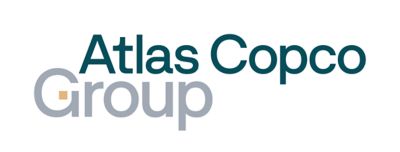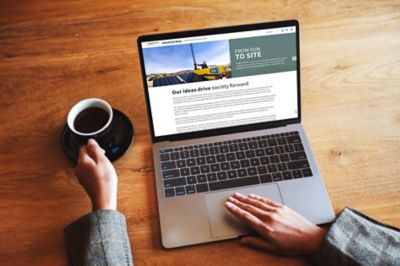ATLAS COPCO Interim report at September 30, 2001 (unaudited)
October 23, 2001
Earnings per share up despite weaker demand
Note: All comparative figures are for the third quarter of 2000, unless otherwise stated. Near-term development Atlas Copco is basing its near-term activities on the current demand situation, which is as follows: Still weak in North America and relatively good in Europe, the Middle East, and Africa. In South America and Asia, the demand is now declining from recent good level. Contingency plans to cope with a more negative scenario have been implemented or are ready to be executed. Summary of nine-month results Atlas Copco Group Orders received for the first nine months advanced 12%, to MSEK 38,573 (34,451), corresponding to volume growth of 1% for comparable units. The positive translation effect from foreign exchange rate fluctuations was 11 percentage points. Revenues rose 13%, to MSEK 38,022 (33,686), corresponding to volume growth of 1%. The Group's operating profit rose 5%, to MSEK 4,782 (4,569), giving a profit margin of 12.6% (13.6). Profit after financial items amounted to MSEK 3,646 (3,318), up 10%, corresponding to a margin of 9.6% (9.8). The total impact of foreign exchange rate fluctuations was approximately MSEK +425. Operating cash flow before acquisitions and dividends equaled MSEK 3,881 (461). Review of third quarter Atlas Copco Group Market development Before September 11, overall demand in North America was thin. The terrorist attacks in New York and Washington further quelled demand. Some immediate effects on equipment, accessories, and short-term rental demand were seen. Most notably affected was equipment such as industrial, professional electric, and light construction tools, driven by production and construction activity. Construction activity in the United States, particularly in the non-residential segment, was on average less than in the preceding year, primarily affecting demand in the equipment rental business. Demand from the mining sector in South America was relatively good, despite less favorable market conditions. This helped to compensate for the effects of the general economic slowdown in Brazil, the biggest market in the region. In Europe, overall demand remained healthy. Many markets in Western Europe, including Germany and France, recorded robust demand for investment-related equipment like high-end industrial compressors, advanced fastening tools and systems, and surface drilling rigs. However, demand for standard compressors and tools from construction as well as manufacturing industries was generally weaker than in the first half of the year. In Central and Eastern Europe, demand for equipment, consumables, and service remained buoyant. The Middle East also sustained a favorable level of demand. In Africa, the situation was mixed, with solid demand from industrial and construction customers, and somewhat softer needs from mining than in recent quarters. In Asia, demand growth was flatter than previous quarters, mainly due to weaker economic development in Southeast Asia and more modest growth in China. Orders and revenues Orders received totaled MSEK 12,885 (11,743), up 10%. Order volumes were 1% lower, though, as almost the entire increase resulted from positive foreign exchange effects of about MSEK 1,200. The Compressor Technique business area achieved volume gains, while the other three business areas recorded less volume than in the same quarter of 2000. Revenues rose 11%, to MSEK 13,041 (11,795), corresponding to unchanged volumes for comparable units. Earnings and profitability Operating profit declined 4%, to MSEK 1,627 (1,700), compared to the same quarter the preceding year. This corresponded to a margin of 12.5% (14.4). The lower margin resulted mostly from lower profit in the U.S.-based Rental Service business area, while the other business areas were in line with the previous year's results. Operating profit includes the positive effects of currency fluctuations, primarily arising from translation gains into a weak Swedish krona. The impact in the quarter was approximately MSEK +150, while the effect on the operating margin was only slightly positive. Net interest expense equaled MSEK -318 (-454), and foreign exchange differences on financial items were negative for the quarter, at MSEK -22 (-1). Strong positive cash flow in the preceding 12 months and lower short-term interest rates had a positive effect on the net interest expense. Profit after financial items increased 3%, to MSEK 1,287 (1,245), corresponding to a margin of 9.9% (10.6). The effects of foreign exchange fluctuations were about MSEK +125. Net profit totaled MSEK 851 (778), or SEK 4.06 per share (3.71). The return on capital employed for the 12 months to September 30, 2001, was 14% (14), and the return on shareholders' equity 13% (13). The Group's weighted average cost of capital (WACC) was about 7.5% (8), for a pretax cost of capital of about 11.5%. Cash flow and investments The operating cash surplus after tax for the third quarter reached MSEK 1,692 (1,834), corresponding to 13% (16) of Group revenues. Working capital decreased MSEK 78 (109) during the quarter, leading to a cash flow from operations before investing activities of MSEK 1,770 (1,943). Net investment in tangible fixed assets was MSEK 357 (1,469) for the quarter. The sharp decrease primarily reflected less need for investment in the rental fleet because of the decrease in rental revenue. Operating cash flow before acquisitions and dividends equaled MSEK 1,403 (453). Summary cash-flow analysis The Group's net indebtedness (defined as the difference between interest-bearing liabilities and liquid assets) amounted to MSEK 22,009 (23,501), of which MSEK 1,766 (1,456) was attributable to pension provisions. The debt/equity ratio (defined as net indebtedness divided by shareholders' equity) was 80% (100). Investments Gross investments in property and machinery totaled MSEK 147 (183). Gross investments in rental equipment reached MSEK 817 (1,851). Depreciation on these two asset groups was MSEK 241 (219) and MSEK 729 (689), respectively, while amortization of intangible assets equaled MSEK 184 (166). People At September 30, 2001, the number of employees was 25,932 (26,592). For comparable units, there were 1,017 fewer employees than at September 30, 2000, and 1,130 fewer than at December 31, 2000. Distribution of shares Share capital equaled MSEK 1,048 (1,048) at the end of the period, distributed as follows. (Published July 19, 2001) In North America, demand for our products and services is not expected to improve in the nearterm. Demand for equipment rental is affected by the general economic situation, and we now expect flat to moderate growth. In Europe, we expect demand to weaken somewhat from recent good levels. In Asia, we expect growth to continue, mainly due to continued strong growth in China. In summary, overall demand for Atlas Copco's products and services is expected to be somewhat lower or at best unchanged. Accounting principles This interim report has been prepared in accordance with the Swedish Financial Accounting Standards Council's recommendation RR20, Interim reports. A number of new accounting standards were implemented in Sweden at January 1, 2001. The application of these new standards did not have any material effect on the Group's financial statements. Compressor Technique Business Area The Compressor Technique business area consists of five divisions in the following product areas: industrial compressors, portable compressors, generators, and gas and process compressors. Order intake advanced 15%, to MSEK 4,249 (3,693), corresponding to 3% real volume growth. The positive impact of currency translation was about 10%, and the net effect of structural changes was +2%. Slower economic growth in most geographic markets negatively affected order volumes for small, standardized industrial compressors. At the same time, orders for large investment-related machines continued to grow. Recently introduced products with customer-oriented features are still recording particularly good sales. The volume of orders for portable compressors and generators grew despite rather weak construction activity in many markets. Overall, the after-market business continued to grow. Good performance was recorded in Europe, as Germany remained strong and growth continued in Eastern Europe. A slowdown was noted in Southern Europe, though. The order level in North America clearly remained below the preceding year's, but the difference was narrower than in recent quarters. A decline was recorded in Asia, with the exception of China and India. The Middle East showed a healthy order intake. To further enhance product development and innovation, the business area completed a large investment in new laboratory facilities in Antwerp, Belgium. A second extension of the assembly plant in Wuxi, China, was inaugurated to support growth in that region. Revenues grew 19% in the quarter, to MSEK 4,324 (3,643), corresponding to volume growth of 7%. Operating profit improved 19%, to MSEK 829 (698), for an operating margin of 19.2% (19.2). The increase in profits resulted mainly from a higher invoicing volume, efficiency measures taken, and currency translation effects because of the weak Swedish krona. The return on capital employed (preceding 12 months) was 67% (57). Construction and Mining Technique Business Area The Construction and Mining Technique business area consists of five divisions in the following product areas: drilling rigs, rock-drilling tools, exploration equipment, construction tools, and loading equipment. Orders received increased 7%, to MSEK 1,701 (1,591), a decrease in volume of 2%. The currency translation effect was +6%, and the net effect of structural changes was +3%. Investments in the mining industry slowed during the quarter, while production levels stayed relatively high. Order intake was good in Chile, Peru, Russia, and Australia, while order intake in southern Africa softened somewhat compared to the preceding quarter's high level. Orders in the United States were up, despite generally sluggish mining activity in North America. Sales expanded to certain construction-related applications, such as quarries. However, equipment demand for large construction projects was weak with a few exceptions, notably Japan and the Middle East. Sales of light construction equipment suffered from weak building activity in many countries, among them Germany, as well as weak demand from rental companies because of depressed investment in fleet. Revenues from consumables, service, spare parts, and accessories continued to increase overall, reaching 57% of total revenues in the quarter. In line with its strategy to become a world leader in the exploration drilling business, the Group acquired U.S.-based Christensen Products. The company has annual revenues of about MSEK 160. Revenues were MSEK 1,766 (1,726), up 2% overall thanks to positive currency translation effects but down 5% in real volume. Operating profit for the quarter rose 9%, to MSEK 178 (164), corresponding to a margin of 10.1% (9.5). Efficiency improvements explained the better margin, while the negative effect of lower invoicing volume was offset by changes in exchange rates compared to 2000. The return on capital employed (preceding 12 months) was 22% (20). Industrial Technique Business Area The Industrial Technique business area consists of four divisions in the following product areas: industrial power tools, professional electric tools, and assembly systems. Orders received increased 2%, to MSEK 2,987 (2,915), corresponding to a drop in volume of 6%. The positive currency translation effect was 10%, and the average price level rose 1%. Structural changes in India had a negative effect of 2% in the quarter. Orders for industrial tools for most customer segments in the United States- the motor vehicle industry, aerospace, and general industry-weakened in the quarter and suffered further from a ???wait-and-see??? reaction by customers after September 11. In Europe, industrial tool sales continued to grow, although some hesitation was noted among customers following the events in the U.S.. Orders from the motor vehicle industry sustained a healthy level, primarily in Germany and France. Sales of professional electric tools declined year-on-year. In the United States, order intake was noticeably positive in July and August, but that pattern was broken in September. Positive contributions came from strong sales for accessories and an extended product offering through home centers. In Europe, demand continued to weaken, mainly affecting the northern part of the region, including Germany. With few exceptions, volume outside Europe and North America (accounting for less than 10% of sales) contracted in the third quarter. Revenues were up 5%, to MSEK 3,002 (2,869), a drop in real volume of 4%. Operating profit rose 2%, to MSEK 305 (298), and the profit margin was 10.2% (10.4). The margin suffered from lower invoicing volume but benefited from the weak Swedish krona, a strong U.S. dollar, and some rationalization gains. Return on capital employed (preceding 12 months) was 15% (15). Rental Service Business Area Since January 1, 2001, the Rental Service business area has consisted of a single division in the equipment rental industry in North America, providing services to construction and industrial markets. Revenues were up 9%, at MSEK 4,094 (3,751), corresponding to a volume decrease of 4%. Rental revenues (71% of total revenues) recorded a volume drop of 10%. On average, rental rates were slightly higher than in the same quarter of 2000. Revenues from sales of new equipment, parts, and merchandise (16% of total revenues) were down about 10% from 2000, while sales of used equipment (13% of total revenues) surged more than 50%. Lower rental revenues resulted from less than normal seasonal pick-up in construction activity in the third quarter, the effects of price increases on certain product categories, and some short-term effects of the September 11 terrorist attacks. The industrial business grew, while the construction business declined in most regions. Rental revenue continued to grow in Canada and Mexico. Sales of new equipment and merchandise plummeted immediately after September 11. The sharp rise in sales of used equipment reflects management's strategy and commitment to adjust the mix of the rental fleet and the fleet size to current demand. Internal efficiency-enhancing projects continued, with benefits appearing in operating expenses. The total number of employees decreased by 91 in the third quarter and by 906 since Dec. 31, 2000. Also, the re-balancing of store locations to current demand patterns continued. Another 16 rental stores were consolidated, and three new stores were opened (now 547 in total). The need for investment in the rental fleet remained substantially less than in 2000. Combined with better management of receivables, this resulted in yet another quarter of healthy cash flow. Operating profit, which includes all related goodwill amortization, was MSEK 378 (469), corresponding to a margin of 9.2% (12.5). The preceding year's profit included MSEK 127 in restructuring costs. The weaker operating margin primarily arose from lower rental revenue, and a bigger share of sales of used equipment at lower than average profit margins. The return on capital employed (preceding 12 months), including goodwill on acquisitions, was 5% (6). Stockholm, October 23, 2001 Giulio Mazzalupi President and Chief Executive Officer Financial targets The overall objective for the Atlas Copco Group is to achieve a return on capital employed that will always exceed the Group's total cost of capital. The targets for the next business cycle are: · to have annual revenue growth of 8 percent, · to have an average operating margin of 15 percent, and · to continuously challenge the operating capital efficiency in terms of stock, receivables, and rental fleet utilization. Overall, achievement of these targets will ensure that shareholder value is created and continuously increased. The strategy for reaching these objectives will adhere to the Group's proven development process for all operational units, focusing on stability first, then profitability, and finally growth. Forward-looking statements Some statements in this report are forward-looking, and the actual outcomes could be materially different. In addition to the factors explicitly discussed, other factors could have a material effect on the actual outcomes. Such factors include but are not limited to general business conditions, fluctuations in exchange rates and interest rates, political developments, the impact of competing products and their pricing, product development, commercialization and technological difficulties, interruptions in supply, and major customer credit losses. For further information: Media Annika Berglund, Senior Vice President Group Communications Phone: +46 8 743 8070, Mobile: +46 70 322 8070, [email protected] Analysts Mattias Olsson, Investor Relations Manager Phone: +46 8 743 8291, Mobile: +46 70 518 8291, [email protected] Overhead presentations from Atlas Copco For your convenience, an overhead presentation of Atlas Copco's third-quarter results will be published on Atlas Copco's Internet site. Please go to www.atlascopco-group.com > Investor Relations > Presentations Internet site for the Atlas Copco Group More information is available at www.atlascopco-group.com. Interim report as per December 31, 2001 The fourth-quarter report will be published on February 14, 2002.





